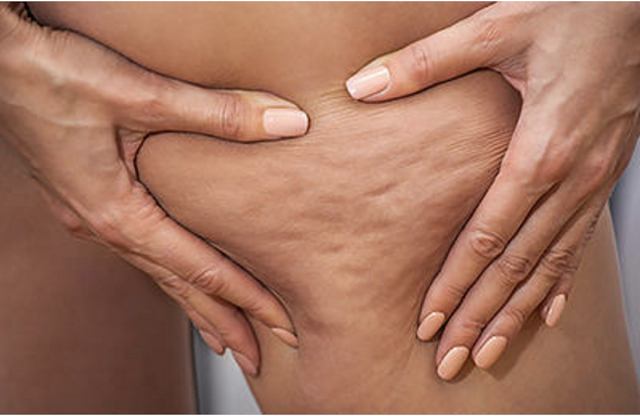Cellulite Removal Benefits
If cellulite bothers you, you’re not alone. Our desire to get rid of — or at least diminish — cellulite has led to many treatment options. With so many treatments out there, it can be hard to know what, if anything, works.
To find out, dermatologists have been conducting research studies. You’ll be happy to know that the research shows some treatments can make cellulite less noticeable — at least for a while. Here’s the lowdown.
Do you have uneven, lumpy skin on your hips, thighs, or buttocks? This may be a sign of cellulite. Cellulite occurs when the skin overlying certain areas of fat is pulled downward to the deeper tissues by connective tissue bands. This creates an uneven surface.
Cellulite is commonly found on:
- hips
- thighs
- abdomen
- buttocks
- breasts
The distribution of fat in women is more visible than in men. The collagen fibers between the skin and muscle separate the underlying fat into multiple pockets. Cellulite can become more visible as you age and your skin becomes thinner and loses elasticity. This exposes the rippled connective tissues underneath.
Cellulite may be caused by:
- hormones
- poor diet
- an unhealthy lifestyle
- accumulated toxins
- genetics
- weight gain
- inactivity
- pregnancy
Women tend to carry more fat around their hips and thighs. We also have less supportive connective tissue to keep it all in place. "If you think of a scaffolding outside a building that has those X crosses on them, that is sort of what men's fat chambers have," says David McDaniel, MD, director of the Institute for Anti-Aging and assistant professor of clinical dermatology at Eastern Virginia Medical School. It is estimated, however, that about 10% of men suffer from cellulite, as well.
Hormones also seem to play a role in the appearance of cellulite: As women age, their bodies produce less estrogen—a hormone that helps keep blood vessels flowing smoothly. Less estrogen can mean poorer circulation, which can also mean a decrease in new collagen production and the breakdown of older connective tissue.
A regular exercise practice cannot cure cellulite—but in many cases it can help prevent or reduce its appearance. Cellulite occurs when connective fibers underneath the skin become weak or lose their elasticity, but stretching and strengthening those areas (in addition to burning away excess fat overall) can help. "Firming and toning those muscles will in turn tighten the skin, giving the illusion that cellulite is less noticeable," says Dr. McDaniel. Yoga routines that target the butt and thighs can help, as well as strength-training moves that build muscle and boost circulation.
Injectable dermal fillers like Restylane and Radiesse, used primarily to plump up sagging cheekbones and remove facial wrinkles, have also shown to be beneficial—at least temporarily—for cellulite-plagued sections of skin. "It's like putting icing on a lumpy cake to make it look better," says Dr. Karcher. "Especially if someone is really skinny and they have a few really deep divots, a filler can plump that up and even it out really well. However, the procedure can cost hundreds or even thousands of dollars per leg, she adds, and the results tend to only last a few months.
Laser, radio-frequency, and massage techniques have been used for several years to reduce the appearance of cellulite—and while their results are not permanent, they are effective in the short-term, says Dr. Karcher. "These are going to work better than some drug-store cream, and they can be worth it if you have the time and the money to spend on them." Some (like TriActiv and VelaSmooth laser treatments) require 10 to 15 sessions to significantly improve appearance, and require monthly maintenance appointments. Others (like the radio-frequency treatment Thermage CL) are more expensive but results seem to last six months to a year.
Your diet alone can't determine whether you will or will not get cellulite, but eating a well-balanced, plant-heavy diet can reduce inflammation throughout your body and help you maintain a healthy weight, says Dr. McDaniel. Staying hydrated—both by drinking water and by eating plenty of foods with high water content—will also keep your connective tissue strong and supple, and may even help you slim down. Aim to eat more cucumbers, radishes, tomatoes, and bell peppers, which (along with many other fruits and veggies) are all more than 90% water.
Cigarette smoke has been shown to reduce blood vessel flow and to weaken and disrupt the formation of collagen, allowing for the connective tissue to become stretched and damaged more easily and for underlying fat to show through. Plus, smoking can make you look bad (literally) in lots of other ways, as well: It causes premature wrinkles and aging, leave skin dry and discolored and can contribute to stretch marks, to name a few.
This one's not exactly true or false, but scientists do seem to be getting better and better at finding long-term solutions for treating trouble spots. The most recent and promising procedure is a surgery, approved by the FDA in 2012, in which an optic laser melts fat, breaks up fibrous connective tissue and stimulates the growth of new collagen, all through a pinhole-sized incision in the skin. "It's great because it works on both those fibers that are pulling down your skin and on the fat globules that are popping through," says Dr. Karcher. Recovery is quick, too: "You might be a little bit sore afterward, but you can have it done on a Friday and be back to work by Monday." The treatment starts at about $3,500 per leg, but results seem to last at least a year or two.
Hormones also seem to play a role in the appearance of cellulite: As women age, their bodies produce less estrogen—a hormone that helps keep blood vessels flowing smoothly. Less estrogen can mean poorer circulation, which can also mean a decrease in new collagen production and the breakdown of older connective tissue.
A regular exercise practice cannot cure cellulite—but in many cases it can help prevent or reduce its appearance. Cellulite occurs when connective fibers underneath the skin become weak or lose their elasticity, but stretching and strengthening those areas (in addition to burning away excess fat overall) can help. "Firming and toning those muscles will in turn tighten the skin, giving the illusion that cellulite is less noticeable," says Dr. McDaniel. Yoga routines that target the butt and thighs can help, as well as strength-training moves that build muscle and boost circulation.
Injectable dermal fillers like Restylane and Radiesse, used primarily to plump up sagging cheekbones and remove facial wrinkles, have also shown to be beneficial—at least temporarily—for cellulite-plagued sections of skin. "It's like putting icing on a lumpy cake to make it look better," says Dr. Karcher. "Especially if someone is really skinny and they have a few really deep divots, a filler can plump that up and even it out really well. However, the procedure can cost hundreds or even thousands of dollars per leg, she adds, and the results tend to only last a few months.
Laser, radio-frequency, and massage techniques have been used for several years to reduce the appearance of cellulite—and while their results are not permanent, they are effective in the short-term, says Dr. Karcher. "These are going to work better than some drug-store cream, and they can be worth it if you have the time and the money to spend on them." Some (like TriActiv and VelaSmooth laser treatments) require 10 to 15 sessions to significantly improve appearance, and require monthly maintenance appointments. Others (like the radio-frequency treatment Thermage CL) are more expensive but results seem to last six months to a year.
Your diet alone can't determine whether you will or will not get cellulite, but eating a well-balanced, plant-heavy diet can reduce inflammation throughout your body and help you maintain a healthy weight, says Dr. McDaniel. Staying hydrated—both by drinking water and by eating plenty of foods with high water content—will also keep your connective tissue strong and supple, and may even help you slim down. Aim to eat more cucumbers, radishes, tomatoes, and bell peppers, which (along with many other fruits and veggies) are all more than 90% water.
Cigarette smoke has been shown to reduce blood vessel flow and to weaken and disrupt the formation of collagen, allowing for the connective tissue to become stretched and damaged more easily and for underlying fat to show through. Plus, smoking can make you look bad (literally) in lots of other ways, as well: It causes premature wrinkles and aging, leave skin dry and discolored and can contribute to stretch marks, to name a few.
This one's not exactly true or false, but scientists do seem to be getting better and better at finding long-term solutions for treating trouble spots. The most recent and promising procedure is a surgery, approved by the FDA in 2012, in which an optic laser melts fat, breaks up fibrous connective tissue and stimulates the growth of new collagen, all through a pinhole-sized incision in the skin. "It's great because it works on both those fibers that are pulling down your skin and on the fat globules that are popping through," says Dr. Karcher. Recovery is quick, too: "You might be a little bit sore afterward, but you can have it done on a Friday and be back to work by Monday." The treatment starts at about $3,500 per leg, but results seem to last at least a year or two.
Wellness Weston Spa & salon
954-652-1343
1348 SW 160th Ave Sunrise Fl 33326





Comments
Post a Comment